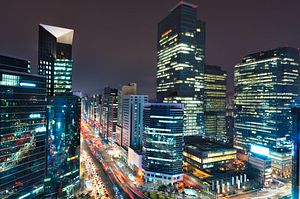While South Korea has an enviable unemployment rate, currently hovering at about 3.9 percent. Yet that figure obscures many complexities about the working environment in Korea.
In what is frequently described as an economic miracle, Korea’s economy has grown dramatically since the 1970s. This success has in large part been the result of the labor of women working in low-status and low-wage jobs within the manufacturing sector; “The Miracle on the Han River” was achieved on the backs of female factory workers. The female labor force participation rate increased from 26.8 percent in 1960 to 47.6 percent in 1995, as women left the rural areas and moved to the cities to find work in the new factories and businesses. Until the early 1990s, women were employed in labor-intensive sectors such as textiles, food processing and manufacturing. These sectors provided the export goods that enabled Korea’s economic growth, and yet little is said of the contribution of women to the development of Korea.
Women represent a large pool of untapped labor in the Korean economy. Their labor participation rate is low by the standards of advanced economies: about 57 percent of women are economically active, compared with 73 percent in Sweden and 69 percent in Germany. South Korean women also drop out of the labor force at a much higher rate when they marry or have children, leading to a 15 percentage point dip in the labor participation rate of women in their 30s. In essence, Korea is losing, from an economic standpoint, potential workers. Yet, women’s participation in the labor force has not always been this low. What has caused this decrease in the presence of female workers? In fact, two reasons can be cited.
First, women continue to drop out of the labor force to marry and raise children. Between the ages of 30 to 39, labor participation rates for women are 15 percentage points below the national average (of just 57 percent). Compounding this, as articulated in the McKinsey Global Institute 2013 study on Korea, is the idea of the inverted “double cascade”: participation in the labor force by highly educated women peaks in their 30s and never rebounds, depriving the economy of highly productive talent. Women in Korea either choose to leave the workplace and their careers to have children or are pushed out by male co-workers who don’t believe women can be both worker and mother. For this reason, the number of women who are able to rise to senior ranks in management and public office is starkly lower than the number of women simply present in the labor force.
Korean women with high levels of education actually have a more difficult time being accommodated in the workforce. According to the World Economic Forum’s Global Gender Gap Report 2012, the current ratio of women to men in upper management positions and public office is a meager 1 to 9. At 104th, Korea ranks below some of the world’s least developed countries, such as Burkina Faso, Malawi and Syria. As a result, Korea faces a peculiar situation in which the more educated a woman is the less likely she is to find work befitting her qualifications. Highly educated women have good reason to stay on the sidelines: women who choose to re-enter the labor force are often unable to secure the level of employment they once had and instead settle into temporary or low-skill work, regardless of education and previous experience.
In another unfortunate turn of events, those women who do stay in the work place and forego marriage and childbearing until they advance their career are also left battling another issue: unequal work pay. Women in Korea make on average 39 percent less than men. This difference in wages ranks Korea bottom amongst peer nations in regards to pay equality. The staggering disparity between men and women in the workforce, especially in upper management positions, compounded with the wage inequality, is a troubling indicator of prevailing attitudes.
Though hope for greater gender equality was anticipated with the election of the country’s first female president, gender discrimination is still rampant. More generally, women are still categorically inferior in the eyes of men. South Korea needs a series of initiatives that will enable women to work up to their capabilities, even after they have children. The country has been sitting at an economic crossroads for many years now. By itself, the growth formula that brought the nation out of poverty and into wealth no longer serves overall society, especially in the absence of a positive emphasis on promoting women in the economy.
Korean people have yet to see any initiatives or rhetoric from President Park Geun-hye vis-à-vis de jure or de facto gender equality (both in the workplace and society at large). If Korea hopes to move forward, it must find a way to reconcile its present with its past and make women equal partners in the fight for prosperity. Sadly, there are no signs of substantial efforts being made to do that in the near future.
Michelle Kwon is a Fulbright Junior Scholar to South Korea.

































